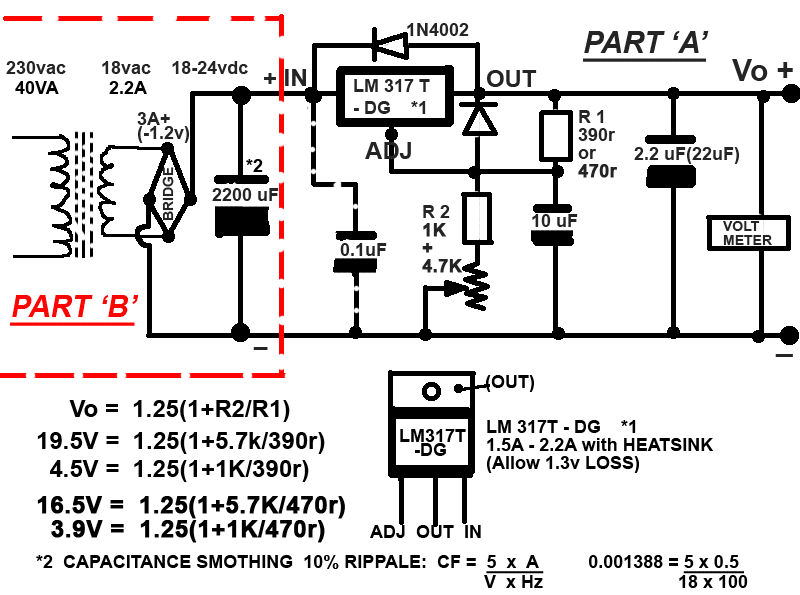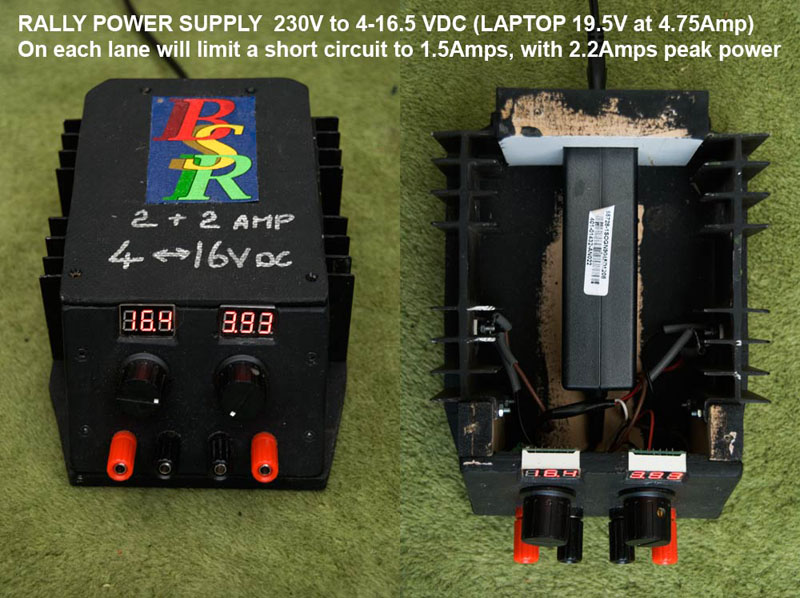The LM range of DC positive rail regulators
Most 1/32 scale motors run at less than 0.7 Amps, except when starting when initial current can exceed 4 Amps, however this starting(stall) current is only for milliseconds and once a motor is turning current is dramatical reduced. If a motor is in its stalled condition for to long a burn out will be inevitable, so this is were current limiting plays its part, also removing the danger of a tracks short circuit damaging the control equipment.
The LM317T is rated at 1.5A and you can not not guaranty more than 1.8Amps peak current, and while the LM317T-DG is still rated at 1.5A it can handle a current of at least 2.2amps, also there is the LM338T (£1.80ea) that can handle 5 Amps with a similar circuit, all will need good heat sinks.
At Banbury the main DC power is 8.8Amps at 18V, divided by four LM317-DG's to give from 4V to 16.5v at 2.2 amps for each for the four lanes. I have also used these regulators for other applications, in one case two LM317T-DG in parallel with one shared resistor network to double the current capacity to 4+ Amps.
The LM317T-DG limits DC current to 2.2Amps in the first place by reducing Volts, as a result you may see a momentary drop in volts from the power supply prior to a high power motor starting to turn.
(Note: It is normally possible for the LM317T-DG to peak at 2.5Amps for just milliseconds)
If the motor then fails to rotate, or through a fault in the power train there is a continuing demand for excessive current, the thermal overload protection of the LM317T will start to shut down. This is achieved by reducing output voltage so that current is limited to 1.5 Amps, finally if a full short circuit is detected the output Volts and Amps drop to Zero. This process is indicative of most regulated power supply’s, and while having a higher wattage power supply may seem desirable there is increased risk of damage if a fault occurs.
This is the circuit details for the adjustable regulated power supplies used for Slot Rally and at Gaydon Slot Festival and is made up of two parts, a Voltage Regulator part 'A' and a DC supply part 'B'. Part 'A' is suitable for dividing a single high amp DC source in to a number of individual voltage regulated lanes, providing each with current limiting.
PART 'A' of the LM317T-DG Regulated Power Supply circuit.
The LM317T DG is a 1.5Amp 1.2V to 37V positive rail regulator, DG indicates a Dual Gage that allows for a grater current of at least 2.2 Amps with suitable heat sink, is a low cost item that is vertically bullet prove with 1.5Amps short circuit limit and thermal protection. The heat sink should be electrically isolated from any other device, as the LM317T metal backing is common with the output. The LM317T-DG at a minimum needs the resistor divider network R2 / R1, with regulation improved with additional optional capacitors and if used I over rate at 64 volts as capacitors are normally the first to fail in any power supply.
An input bypass capacitor of 0.1 µF if the LM317T is more than 15cm from the DC source, a adjustment terminal to ground 10 µF capacitor to improve the ripple rejection of about 15dB, and up to 22 µF Aluminium electrolytic capacitor on the output to improve transient response. In additional it is good practice to add diodes to protect the device against input short circuit, and output short circuit for capacitance discharging. To ensure good regulation you need a minimum load current of around 5 mA, achieved by the addition of a 30 volt DC LED volt meter, all can be assembled with out the need for a printed circuit board.

PARTS LIST for a single unit Regulator (rapid part number):
LM317 DG (47-3321) x 1 £0.43
Heat Sink I now cut mine from an old copper water tank 6.5cm Sq, surface area 85 Sq cm. (For aluminium 150 Sq Cm)
TO220 Mica Insulating kit PK 0f 10 (38-0212) £0.92 (To isolate? You will also need 2.5mm fixing screws)
1K ohm resistor x 1 (62-0370 : resistors are approx £0.80 100 Pk)
470 ohm resistor x 1 (62-0362 : I use resistors from stock)
4.7K 24mm Potentiometer (65-0510) x 1 £0.75
24mm Knob / 6mm shaft (32-0285) x 1 £0.62
1N4002 1A/100V Diode (47-3132) x 2 £0.14
22 uf 63v capacitor (11-0335) x 1 £0.07
10 uf 63v capacitor ((11-0225) x 1 £0.05
4mmTest Terminal RED (17-2698) x 1 £0.39
4mm Test Terminal BLACK (17-2696) x 1 £0.39
Mini DC 2.5 – 30 V LED Panel Meter (ebay) x 1 £1
Total from £4 to £5 per lane
PART 'B' providing the conversion from 230 V AC to DC.
Part 'B' shows a traditional way of converting 230V AC to a lower DC volts, the full rectifier bridge will lose around 1.2 volts, while the capacitor will smooth and increase the bridge output by up to 1.4 x depending on capacitor size and current load. I always build my units with at least two outputs, that will need 2.2+ Amps x 2 (4.5 Amps), 80VA at 18 volts for a twin unit.
For rally I have used a laptop 4.7Amp switched power supply to give TWO regulated outputs, with these you need to allow for a volt drop under load and through the LM317T, with 19.5v down to 17v output, or 24v down to 20v.
Using a 12(12.6)volt DC car battery is also an option, and while the LM317T will limit maximum current I strongly recommend a suitable fuse at the battery end, you will get no more than 11 volts regulated but it will be more than enough for use at a public event such as outdoor charity fund raising.
AC 230V to 19.5V 4.7A 90W DC Laptop ADAPTER Charger (ebay) £7
AC 100V-240V Converter Adapter DC 24V 5A 120W Power supply (ebay) £9
(Do NOT use 24V unless you need to run at 19+volts as any 'unused volts' will put more load on the LM317T.)

The laptop power supply and LED volt meters are obtained through ebay, and the rest from RAPID Electronics (rapidonline.com). If you have suitable heat sink material (Aluminium/Copper), can use a soldering iron and have something to make the case with (MDF), it costs from £16 to make the 230vAC - 16vDC twin regulated power supply.
TRACK POWER LOSS:
In addition to your power supplies, you should consider volt(power) loss through the track and wiring. If using Scalextric sport the connections are not the best and at Banbury we wire link up to four straights under each joint. The four main bends are all fully wire linked plus direct power lines (jumpers), each of the four 90ft lanes have six direct power links (jumpers) in total. You can test each lane for volt(power) loss by setting the controller to full power with no cars, placing a 7W 47ohm resister across the rails generating a load of 0.25amps at 12V, and at this point with a volt meter compare volts loss with the power supply output: E.G.: I=V/R ; for each ohm V loss = R x I (4 ohms = 1 volt loss at 0.25amps)
As minimum use 0.75mm copper cable for the longer jumper links(speaker cable is more flexible) a return pair will still add some volt loss, with 6 Amp 0.75 speaker cable £3 /10M (about 1.2 ohms per 10M), 1mm 10 Amp twin mains £6.30 / 10M (0.7 ohms for 10M) or 1.5mm 15Amp speaker cable at £4 / 10M (0.38ohms / 10M) .